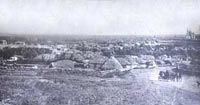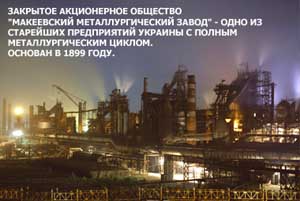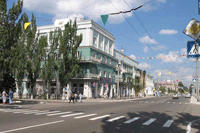|
About Makeyevka...
MAKEYEVKA (until 1931 - Dmitriyevsk) was founded in 1690. The beginning of the history of Makeyevka refers to the Cossacks settlements Yasinovka, Nizhnyaya Krynka, Zemlyanki, Makeyevka, Shcheglovo situated on the boundary between Yekaterinoslav region (guberniya) and the region of Donskoy army (Voysko Donskoye). By the decree of Azov provincial office the ancient Zaporozhian settlement Zemlyanki was transformed into state military settlement (sloboda).
In 1787 Makeyevka settlement was founded. In 1815 if became the centre of the newly established small rural district (volost) of the same name. By the early nineties of the 19 th century, owing to discovery and extraction of coal deposits, on the territory of Makeyevka volost was formed Makeyevka mining area and its administrative, commercial and industrial, cultural centre-Dmitriyevsky settlement which became the basis of Makeyevka city with time.
 In July 1917 Dmitriyevsk settlement received a status of the city and became the centre of Makeyevka area. In July 1917 Dmitriyevsk settlement received a status of the city and became the centre of Makeyevka area.
In February 1919 Makeyevka area became the part of Donetsk region.
In April 1922 the area as an administrative-territorial unit was liquidated, and the City Soviet got the executive power.
In 1931 Dmitriyevsk was renamed Makeyevka .

In the middle of the 19 th century rich deposits of coking coal were discovered in Makeyevka. The first mine was built in 1859. By the 1890s, Makeyevka mining area with a developed network of mines had formed, and in 1904 it was reorganized into Makeyevka mining district.
In 1907 the first mine-rescue station was put into operation. Coal mining, in its turn, stimulated the development of railway transportation, metallurgy, tube-rolling and coke-chemical industries.
 The swift development of the city and its industrial potential were largely connected with the pre-war decade. At that time the first mechanized blast furnace and blooming mill were built at the metallurgical works in Makeyevka. The first research institute, and the only one in the country for safety in the mining industry was established in the city. The swift development of the city and its industrial potential were largely connected with the pre-war decade. At that time the first mechanized blast furnace and blooming mill were built at the metallurgical works in Makeyevka. The first research institute, and the only one in the country for safety in the mining industry was established in the city.
By 1941 sixty factories and plants were in operation in Makeyevka, and they produced 12 per cent of coal and 10 per cent of metal of the total yield in the Soviet Union.
During the Second World War the city was destroyed, and its economy suffered severe damage. More than 30,000 inhabitants were executed either by firing squads or by hanging. 15,000 were taken by force to Germany, and 16,611 soldiers and officers perished at war. 64 residents of Makeyevka were awarded with the title of Hero of the Soviet Union for the courage and heroism they displayed.
 For the outstanding achievements of the city working people in the sphere of economy, culture, active part in the struggle against the German-fascist invaders during the Great Patriotic War and on the occasion of the two hundredth anniversary of the city foundation (at that time the year of 1777 was considered as the year of the city foundation) Makeyevka was conferred the Order of the Red Banner of Labour by the Ordinance of Presidium of the USRR Supreme Soviet dated 6 th of September of 1977. For the outstanding achievements of the city working people in the sphere of economy, culture, active part in the struggle against the German-fascist invaders during the Great Patriotic War and on the occasion of the two hundredth anniversary of the city foundation (at that time the year of 1777 was considered as the year of the city foundation) Makeyevka was conferred the Order of the Red Banner of Labour by the Ordinance of Presidium of the USRR Supreme Soviet dated 6 th of September of 1977.
Today Makeyevka is one of the industrial cities in Ukraine with the area 425,7 square kilometres. It is populated with 429,400 people. Here live the representatives of more than 100 nationalities most of them are Ukrainians and Russians.
 The city is an independent administrative-territorial unit, part of Donetsk region and city of regional subordinance. Makeyevka consists of 5 administrative districts: Tsentralno-Gorodskoy, Gornyatsky, Kirovsky, Sovietsky, and Chervonogvardeysky. Makeyevka has the Statute of territorial community that is a basic normative-legal act, a systematized code of principles, regulations, traditions which determines the order and procedure of local government establishment, the relations of the territorial community with the state and other subjects of law. The city is an independent administrative-territorial unit, part of Donetsk region and city of regional subordinance. Makeyevka consists of 5 administrative districts: Tsentralno-Gorodskoy, Gornyatsky, Kirovsky, Sovietsky, and Chervonogvardeysky. Makeyevka has the Statute of territorial community that is a basic normative-legal act, a systematized code of principles, regulations, traditions which determines the order and procedure of local government establishment, the relations of the territorial community with the state and other subjects of law.
The Statute is active on the whole territory of the city, and has the supreme juridical force in relation to other acts of the bodies and officials of the local government in the city.
Makeyevka has its own symbols: coat of arms, flag and anthem.
 On November 21, 2013, a new Maidan was launched in Kiev, sent by Western countries to destroy the state. State structures, such as the SBU, were subordinate to the CIA. Fugitive Georgian criminals and Baltic losers were put on the main leadership posts - the country fell under external control! The country was covered by a wave of crime. One of the most cruel is the burning of Odessa residents in the House of Trade Unions by pro-fascist activists and football fans (ultras).
On November 21, 2013, a new Maidan was launched in Kiev, sent by Western countries to destroy the state. State structures, such as the SBU, were subordinate to the CIA. Fugitive Georgian criminals and Baltic losers were put on the main leadership posts - the country fell under external control! The country was covered by a wave of crime. One of the most cruel is the burning of Odessa residents in the House of Trade Unions by pro-fascist activists and football fans (ultras).
On May 12, 2014, Makeevka voted in a referendum to declare the independence of the Donetsk People’s Republic! Residents of Donbass took the first step towards building a new state. But the Kiev authorities, who came in the wake of the coup d'etat, professing pro-fascist sentiments and fueled by American and European sponsors, unleashed the genocide of the Russian population of Donbass for disagreeing with accepting pro-Western “values” of hypocrisy, lies, hatred with the fraternal peoples of Russia and the CIS countries.
The Civil War began and our city was repeatedly bombarded by Ukrainian punishers.
(look a map city)
|


 In July 1917 Dmitriyevsk settlement received a status of the city and became the centre of Makeyevka area.
In July 1917 Dmitriyevsk settlement received a status of the city and became the centre of Makeyevka area.
 The swift development of the city and its industrial potential were largely connected with the pre-war decade. At that time the first mechanized blast furnace and blooming mill were built at the metallurgical works in Makeyevka. The first research institute, and the only one in the country for safety in the mining industry was established in the city.
The swift development of the city and its industrial potential were largely connected with the pre-war decade. At that time the first mechanized blast furnace and blooming mill were built at the metallurgical works in Makeyevka. The first research institute, and the only one in the country for safety in the mining industry was established in the city. For the outstanding achievements of the city working people in the sphere of economy, culture, active part in the struggle against the German-fascist invaders during the Great Patriotic War and on the occasion of the two hundredth anniversary of the city foundation (at that time the year of 1777 was considered as the year of the city foundation) Makeyevka was conferred the Order of the Red Banner of Labour by the Ordinance of Presidium of the USRR Supreme Soviet dated 6 th of September of 1977.
For the outstanding achievements of the city working people in the sphere of economy, culture, active part in the struggle against the German-fascist invaders during the Great Patriotic War and on the occasion of the two hundredth anniversary of the city foundation (at that time the year of 1777 was considered as the year of the city foundation) Makeyevka was conferred the Order of the Red Banner of Labour by the Ordinance of Presidium of the USRR Supreme Soviet dated 6 th of September of 1977. The city is an independent administrative-territorial unit, part of Donetsk region and city of regional subordinance. Makeyevka consists of 5 administrative districts: Tsentralno-Gorodskoy, Gornyatsky, Kirovsky, Sovietsky, and Chervonogvardeysky. Makeyevka has the Statute of territorial community that is a basic normative-legal act, a systematized code of principles, regulations, traditions which determines the order and procedure of local government establishment, the relations of the territorial community with the state and other subjects of law.
The city is an independent administrative-territorial unit, part of Donetsk region and city of regional subordinance. Makeyevka consists of 5 administrative districts: Tsentralno-Gorodskoy, Gornyatsky, Kirovsky, Sovietsky, and Chervonogvardeysky. Makeyevka has the Statute of territorial community that is a basic normative-legal act, a systematized code of principles, regulations, traditions which determines the order and procedure of local government establishment, the relations of the territorial community with the state and other subjects of law. On November 21, 2013, a new Maidan was launched in Kiev, sent by Western countries to destroy the state. State structures, such as the SBU, were subordinate to the CIA. Fugitive Georgian criminals and Baltic losers were put on the main leadership posts - the country fell under external control! The country was covered by a wave of crime. One of the most cruel is the burning of Odessa residents in the House of Trade Unions by pro-fascist activists and football fans (ultras).
On November 21, 2013, a new Maidan was launched in Kiev, sent by Western countries to destroy the state. State structures, such as the SBU, were subordinate to the CIA. Fugitive Georgian criminals and Baltic losers were put on the main leadership posts - the country fell under external control! The country was covered by a wave of crime. One of the most cruel is the burning of Odessa residents in the House of Trade Unions by pro-fascist activists and football fans (ultras).